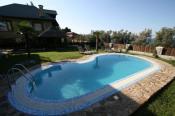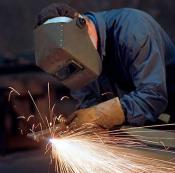Search
Login
Recommended
Polycarbonate, what is it, cellular polycarbonate dimensions, application, cutting methods, fastenings
Cellular, or otherwise, structured or cellular polycarbonate got its name because of its special internal structure: its design can be two, three or four-layer, filled with a certain number of stiffeners, forming triangles, cross-shaped joints or square ones. Examining a leaf in a section, you can notice its similarity to bee honeycombs. Due to this structure, the material has excellent strength characteristics and a high coefficient of flexibility, and the air contained in the cells provides its heat-saving properties.
Content
- Cellular polycarbonate - how is it made
- Properties and advantages of honeycomb material video
- Cellular polycarbonate - sheet sizes and application depending on thickness
- Basic principles of working with polycarbonate video
- Polycarbonate mount video video
- Operation and maintenance of polycarbonate surfaces
Cellular polycarbonate - how is it made

For the manufacture of cellular material, polycarbonate is used - a granular, colorless plastic mass, characterized by lightness, frost resistance, dielectric properties, and durability. The unique structure of polycarbonate macromolecules is the main reason for the unique properties inherent in it.

The thermoplasticity of the material allows it to recover during the hardening process after each melting process, i.e. the material can be processed many times, which is very important from the point of view of environmental friendliness.

Material production is carried out by extrusion, i.e. pushing the melted liquid viscous material through the forming tool. The result is a web having a given cross-sectional shape.
Properties and advantages of honeycomb material

You can immediately notice that polycarbonate compares favorably with any transparent building material - not one of them has the same positive qualities in full.

Cellular polycarbonate is different:
- A low coefficient of thermal conductivity, providing higher heat-saving qualities of the material than glass, which allows reducing energy consumption for heating or cooling rooms by almost half.
- The multilayer structure of the material provides good sound absorption, and, accordingly, good noise insulation qualities.
- The material scatters light rays well, its transparency is 86%, it does not cast a shadow with the passage of light.
- The operation of the material can be carried out at temperatures from -40 C to +120 C, i.e. it can be used in almost any natural area, the qualitative characteristics of the material to a very small extent depend on changes in the environment. It is not susceptible to chemicals.
- Polycarbonate has an insignificant weight, about 16 times less than window glass and 6 times less than an acrylic sheet of the same thickness, the use of the material allows you to get savings by designing a less powerful foundation and reducing the cost of supporting structures. Installation work can be performed without the use of special construction equipment.
- The material has a high viscosity, providing its impact resistance (200 times greater than that of sheet glass), it is resistant to bending and tearing loads. In case of damage with a very strong impact, sharp fragments do not form. The polycarbonate coating can withstand the loads exerted by the accumulated snow, does not break from wind gusts, like a plastic film, which makes it an ideal option for covering greenhouses. Good flexibility of the material allows its use in the installation of roof structures with complex geometry, including arched and vaulted.
- Polycarbonate is not prone to ignition, it does not burn, but under the influence of open fire it melts to form a cobweb-like fiber, while toxic substances are not released.
- The constancy of the technical characteristics of the material is ensured by the protective layer deposited on the front side of the sheets, which delays the ultraviolet part of the solar spectrum.
Cellular polycarbonate - sheet sizes and application depending on thickness

Cellular polycarbonate is available in a wide range of colors, its basic colors:
- warm - red, brown, bronze, orange, yellow, milky,
- cold - white, blue, turquoise, green,
- you can also see transparent panels.
If we talk about the size of the sheets, then it should be noted that polycarbonate is available in several versions:
- monolithic, from 2 to 12 mm thick, with standard sheet dimensions of 2.05x3.05 m,
- mesh, with a thickness of 4 to 32 mm, with sheet dimensions of 2.1 x 6 m or 2.1 to 12 m,
- profiled, 1.2 mm thick, sheet size 1.26x2.24 m, profile height up to 5 cm.

Depending on the thickness of the sheets, cellular polycarbonate application may have different, it is recommended to use during construction:
- 4 mm - canopies and hotbeds, shop windows, exhibition stands,
- 6 mm - canopies, greenhouses, peaks,
- 8 mm - greenhouses, roofs, awnings, partitions,
- 10 mm - continuous glazing of horizontal and vertical surfaces, the manufacture of noise barriers, awnings,
- 16 mm - roofs over large area structures,
- 32 mm - for roofs with increased requirements for loads.

Based on such a wide range of products, before the start of construction, it will be necessary to study the properties and decide which polycarbonate is rationally used in each particular structure.
Basic principles of working with polycarbonate

Since the sheets of material have rather large dimensions during construction, it will be necessary to give them the necessary dimensions, i.e. cut. There are no special problems with cutting polycarbonate, if the sheet thickness is from 0.4 to 10 mm, then you can use a construction retractable sharp knife. It is not recommended to remove the protective film from the surface - it will provide protection from scratches.

The incision should be done carefully, providing an accurate, straight line. For cutting thicker material, you should use a saw with emphasis, working in high speed mode. The teeth of such a saw should be made of reinforced alloys, small, undiluted. You can also use a jigsaw.
During operation, the sheet should be maintained to prevent vibration. Chips that will fall into the sheet during cutting must be removed at the end of work.
To mount the polycarbonate, you will need to drill holes in the sheets. Sharp steel drills are used for this. It is required to mark the place for drilling so that it is located between the internal stiffeners. The distance from the hole to the edge should be about 10 mm.
You can bend cellular polycarbonate exclusively along the lines of the channels along the length of the sheet. The bending radius may exceed 175 times the sheet thickness.
Since there are voids inside the sheets, special attention should be paid to the processing of their end parts. If the sheets will be mounted in a vertical or inclined position, then the ends should be closed with a self-adhesive aluminum strip, and with a perforated one at the bottom, which can protect the material from penetrating dirt, but allowing condensation to drain off.

When using polycarbonate in the construction of an arch structure, it will be necessary to close its ends with a perforated film. Materials for sealing should be selected according to the color of the panel shade.
A few recommendations from experts:
- Aluminum sealants are considered the highest quality, they are durable and easy to use.
- When using non-perforated sealant, holes of the smallest diameter should be drilled in it - for the exit of condensate and vapors.
- Leaving the ends open is not recommended - this will help reduce the transparency of the panels and reduce their life.
- The ends are not recommended to be glued with ordinary tape.
- When mounting sheets, they should be oriented in such a way as to ensure the possibility of unimpeded discharge of condensate.
- The installation of the panels should be planned in such a way that, when installed vertically, the stiffeners are positioned vertically, when constructing a pitched surface - longitudinally, for an arch - arched.
- To perform outdoor work, you should use a material with a layer that protects it from ultraviolet radiation.
Polycarbonate mount

Bearing longitudinal supports for the frame are mounted in increments of:
- for 6-16 mm sheets - 700 mm,
- for 25 m sheets - 1050 mm.
When calculating the distance between the transverse supports are taken into account:
- expected wind or snow loads,
- angle of inclination of the structure.
The distance can be from 0.5 to 2 m.

To fix the polycarbonate, self-tapping bolts or thermowells are used, one of which is a plastic plate with a high rod, the other is a sealant, there is also a snap cap in the kit. The thermal washer provides a strong and tight connection without cold bridges and panel compression. To avoid problems caused by thermal expansion, the holes should have a diameter larger than the section of the foot of the washer by a couple of millimeters.
Do not use nails or rivets to secure the panels! Tightening self-tapping bolts during installation is not recommended. Improper fastening of polycarbonate with self-tapping screws can lead to a reduction in its life.
If one-piece panels are installed, then they should be inserted into the fold of the thickness profile the same as these panels have.

Using self-tapping bolts, they are attached to the longitudinal support. Before starting work, it is recommended to keep the sheets of cellular polycarbonate in a dry, warm room, and only then glue their ends with a self-adhesive tape - in this case, condensation will not form inside the cellular material. To prevent the possibility of surface damage when the profile is snapped, use a wooden mallet.
During installation, it should be borne in mind that polycarbonate is not classified as static material, its dimensions, albeit to a small extent (up to 0.065 mm / m when the temperature changes by 1 degree), but vary from temperature extremes. Therefore, during installation, you should leave the appropriate gaps, but do not forget about the need to use special fasteners that will prevent the panels from slipping when the temperature drops. It is enough that the range of free play was 2 mm per linear meter. The above requirements must correspond to the diameters of the holes procured for fasteners.
Operation and maintenance of polycarbonate surfaces

- Before installation, the panels should be stored in packaged form, transported in a horizontal position.
- It is not recommended to store the panels in direct sunlight or in the rain.
- Do not walk on polycarbonate sheets.
- The panels are cleaned with a soft cloth moistened with a solution of soap or dishwashing detergent.
- Do not use detergents that contain ammonia, acids, chlorine, solvents, salts.
- Sharp objects must not be used to remove dirt - they may scratch the UV protective layer.
- The sheets are installed so that the side on which the protective film is applied is facing out. On the packaging you should find the designation of UV protection.





